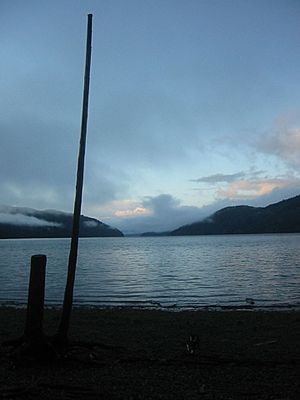Alberni Inlet facts for kids
The Alberni Inlet is a long, narrow arm of the sea on Vancouver Island, British Columbia, Canada. It used to be called the Alberni Canal. This inlet stretches about 40 kilometers (25 miles) from the Pacific Ocean at Barkley Sound all the way to Port Alberni.
It was named by a Spanish explorer, Francisco de Eliza, after Pedro de Alberní y Teixidor. Pedro de Alberni was a captain who served at the Spanish fort in Nootka Sound from 1790 to 1792. The inlet is also important to several First Nations groups. These include the Ucluelet, Uchucklesaht, Huu-ay-aht, Hupacasath, and Tseshaht peoples. They are all part of the Nuu-chah-nulth Tribal Council.
History of the Alberni Inlet
Because it's open to the Pacific Ocean, the Alberni Inlet has experienced tsunamis. A tsunami is a very large ocean wave often caused by earthquakes. The biggest tsunami in recent times happened in 1964. It was caused by the Good Friday earthquake in Alaska. This powerful wave destroyed parts of downtown Port Alberni.
The narrow shape of the inlet made the tsunami waves much bigger and stronger. When the first wave hit Port Alberni, it was about 2.44 meters (8 feet) high. An hour later, an even larger wave, about 3.05 meters (10 feet) high, struck the town. This second wave caused most of the damage. It lifted houses off their foundations and swept huge piles of logs onto the shore.
After that, four more waves hit. They ranged from 1.52 to 1.83 meters (5 to 6 feet) high. These waves arrived about every 90 minutes. In total, the tsunami washed away 55 homes. It also damaged 375 other houses. The First Nations village of Sarita, which is on a low sandy beach along the inlet, has also been hit by tsunamis many times.
Why the Name Changed
In 1931, people suggested changing the name from "Alberni Canal" to "Alberni Inlet." This was to help foreign shipping companies. They often confused "canal" with man-made waterways like the Panama Canal or Suez Canal. These canals charge extra fees for ships to pass through.
The BCGNIS explained the problem. Foreign shippers thought "Alberni Canal" meant extra costs like pilot fees, canal dues, and insurance. They didn't realize it was a natural arm of the sea. Changing the name to "inlet" made it clear that it was a natural waterway. This helped avoid confusion and extra expenses for ships. The name change was officially approved in 1945.
Even with this change, some other inlets on the Northwest Coast still use "canal" in their names. Examples include Lynn Canal, Portland Canal, and Hood Canal.
See Also



